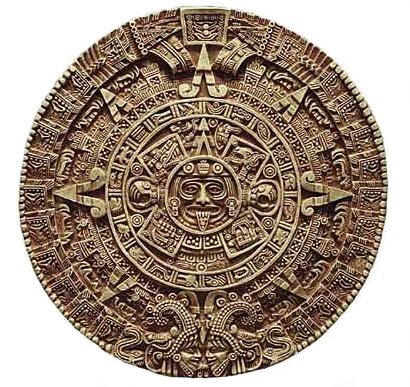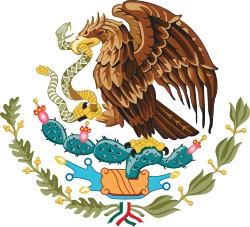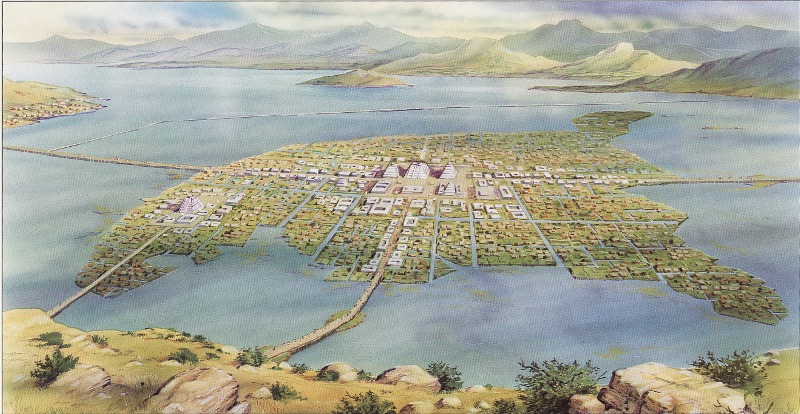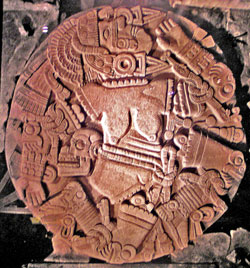|
Location: Lake Texcoco,
Valley of Mexico. |
Grid Reference:
19� 26' N, 99� 8' W. |

 Tenochtitlan: (Aztec Capital)
Tenochtitlan: (Aztec Capital)
Tenochtitlan, the
Capital of the Aztec empire, was built on a cluster of small natural
islands on Lake Texcoco in the Valley of Mexico. The founding of
capital city in the middle of a marshy lake may at first seem
absurd, but its exact location was foretold and fulfilled by
prophesy, and Tenochtitlan indeed grew to become the largest and
most powerful city in Mesoamerica, and at its height was one of the
largest cities in the world.
The city was
originally built by the Aztecs in 1325 as Tenochtitlan, which was almost
completely destroyed in the 1521 siege of Tenochtitlan, and
subsequently redesigned and rebuilt in accordance with the Spanish
urban standards. In 1524, the municipality of Mexico City was
established, known as M�xico Tenochtitl�n, and as of 1585
when it officially became known as La Ciudad de M�xico (Mexico City).
Tenochtitlan:
'Place of the Fruit of the Prickly Pear
Cactus'
Tenochtitlan was the capital city of the
Aztec civilization, founded in 1325 by
the Mexica people. The Aztecs, or Mexica
as they called themselves, were not
originally from the Valley of Mexico,
but had migrated from the north (from a
mythical island called Aztlan, "The
Place of Herons") Historically, it is
known that the Mexica and other tribes
located in northern Mexico and the
southwestern United States, known as the
Chichimeca, left their homes because of
a great drought. This story is told in
several surviving codices, in which the
Mexica are shown carrying with them the
idol of their patron deity Huitzilopochtli. After two centuries
of migration, at around AD 1250, the
Mexica arrived in the Valley of Mexico.
When the Mexica
finally arrived in
the Valley of
Mexico, the earlier
great cities of
Teotihuacan and Tula
had been abandoned
for centuries and
other groups of
people were already
settled on the best
lands. Because of
this the Mexica had
a troubled time and
were forced to
settle on
inhospitable land.
They became vassals
of the city of
Culhuacan, a
prestigious city
whose rulers were
considered the heirs
of the Toltecs. It
is said that in
acknowledgement for
their assistance
during battle, the
Mexica were given
one of the daughters
of the King of
Culhuacan to be
worshipped as a
goddess/priestess.
When the king
arrived to attend
the ceremony, he
found one of the
Mexica priests
dressed in the
flayed skin of his
daughter: the Mexica
reported to the king
that their God
Hutzilopochtli had
asked for the
sacrifice of the
princess. The
sacrifice and
flaying of the
Culhua Princess
provoked a ferocious
battle, which the Mexica lost. After
they were forced out
of Chapultepec,
according to Mexica
myth, the Aztecs
wandered for weeks,
searching for a
place to settle.
Huitzilopochtli
appeared to the
Mexica leaders and
indicated a place
where a great eagle
was perched on a
cactus killing a
snake. This place,
in the middle of a
marsh with no
ground-rock at all,
was where the Mexica
founded their
capital city,
Tenochtitlan. The
year was 2 Calli
(Two House) in the
Aztec calendar,
which translates to
AD 1325.

The vision
is immortalized in Mexico's coat of arms
and the centre of the Mexican flag.
A thriving
culture developed, and the Aztec
civilization came to dominate other
tribes all around Mexico. The small
natural island was perpetually enlarged
as Tenochtitlan grew to become the
largest and most powerful city in
Mesoamerica. Commercial routes were
developed that brought goods from places
as far as the Gulf of Mexico, the
Pacific Ocean and even the Inca Empire.
Only 100 years after its conception,
Tenochtitlan had become a city that
rivalled any of its European
contemporaries and perhaps any in the
world. Scholars estimate that
between 200,000 and 250,000 people lived in
Tenochtitlan in 1500, more than four times the
population of London at that time.
Tenochtitlan: Lake City.
'When we saw so many cities and villages built in the
water and other great towns on dry land we were amazed
and said that it was like the enchantments (...) on
account of the great towers and cues and buildings
rising from the water, and all built of masonry. And
some of our soldiers even asked whether the things that
we saw were not a dream? (...) I do not know how to
describe it, seeing things as we did that had never been
heard of or seen before, not even dreamed about'.
(Bernal
D�az del Castillo
- on
entering the city in 1511 - Extract from 'The
Conquest of New Spain')
(1)

Artistic impression of Tenochtitlan at its height.
The
Aztec capital of Tenochtitl�n (at modern Mexico City)
was founded in 1325 on a muddy island in the lake which
at that time filled the Basin of Mexico. A second group
of Aztecs also settled the nearby island of Tlatelolco
in 1358. Both sites began as small collections of reed
huts but, with the growth of Aztec power, quickly
developed into cities, eventually fusing into a single
unit.
Tenochtitl�n was joined to the mainland by three
causeways.
An aqueduct
supplied fresh water from Chapultepec. Along with the
many palaces and marketplaces of the city the Tecpan,
a central plaza contained the two principal temples,
built on a huge terraced pyramid (El Templo Mayor).
By 1519, the year the Spaniards arrived, Tenochtitl�n
had a population of more than 200,000. It was laid out
on a grid plan and covered more than 12 km2 (4.6 mi2),
much of this consisting of reclaimed swampland that
formed a zone of fertile garden plots around the edge of
the city.
The
Aztec city-states in the valley were an extremely
proficient hydraulic society. They used bridges,
causeways, dikes, sluices, canals, aqueducts, terrace
farming, and chinampas (artificial, floating gardens) to
sustain the population and allow for navigation about
the city. A 16-km
(10-mi) dike sealed off part of the lake and controlled
flooding, so that Tenochtitl�n, like a Mexican Venice,
stood on an island in an artificial lagoon. Causeways
linked the island to the lakeshore, and canals reached
to all parts of the city. The Tenochtitlans used the
aqueduct water from Chapultepec for bathing and cleaning
and they used mountain spring water for drinking and
cooking.
The market district, was estimated by
Spanish explorer Bernal Diaz del Castillo to be twice the size of
Seville and bustling with over 60,000 shoppers and traders. The
produce and goods for this market and several others in the city
came mostly from the intricate and efficiently irrigated gardens
created by the Aztecs in the shallow lakes surrounding the city.
These gardens, called chinampas, were artificial island
plots of 30 x 2.5-3 meters. These �floating gardens� produced 3
crops a year and grew at least a half to two-thirds of the food
consumed by the 200,000 residents of Tenochtitlan. Irrigated by the surrounding lake water, the chinampas were
fertilized by digging up the nutrient-rich mud from the bottom of
the canals and also by using human waste from the city itself. In
this way, Tenochtitlan was able to better fertilize its crops while
treating its wastewater― creating a healthier living environment for
all. Mexico city is currently trying to create a waste-water
treatment system incorporating the use of chinampas similar to the
ones used by the Aztecs so long ago.
(2)
|
Floating
Gardens:
The chinampas system is
now being used in Bangladesh demonstrating the potential of
applying ancient techniques to solve modern problems.
(Quick-link) |
El
Templo Mayor:
At
the centre of Tenochtitl�n was a large walled precinct, the
Teclan, presumed to be the focus of ceremonial and sacred
activity, containing the main temples (dedicated to Huitzilopochtli,
Tlaloc the Rain God, and Quetzalc�atl); also found there were
schools and priests' quarters, a court for the ritual ballgame, a
wooden rack holding the skulls of sacrificial victims, and many
other commemorative sculptures. The largest structure of the complex
was the Templo Mayor, said to be the very location of the fulfilment
of the Aztec prophesy.

El Templo
Mayor, built in the heart of the city and the largest
building, said to be the location where the prophesy
for building the city was fulfilled.
 The
Templo Mayor was effectively destroyed in 1521 after Tenochtitl�n was
conquered by Hern�n Cort�s, and Mexico City was built over its
ruins. It was rediscovered accidentally in 1978 workmen digging a
trench for an electricity cable northeast of the Cathedral found a
monumental 3.25m diameter stone disk carved with the image of the dismembered
moon goddess Coyolxauhqui. (See image right) The
Templo Mayor was effectively destroyed in 1521 after Tenochtitl�n was
conquered by Hern�n Cort�s, and Mexico City was built over its
ruins. It was rediscovered accidentally in 1978 workmen digging a
trench for an electricity cable northeast of the Cathedral found a
monumental 3.25m diameter stone disk carved with the image of the dismembered
moon goddess Coyolxauhqui. (See image right)
According to Aztec
legend, when Coyolxauhqui was killed on the summit of Coatepec by
Huitzilopochtli, her beheaded body was torn apart when it
fell down the mountainside. A monument to Coyolxauhqui, thus, would
be expected to be found at the foot of a "mountain,". Excavation
soon revealed huge serpent heads, which turned out to flank
stairways to the temple top where, as might be expected, there was a
shrine to Huitzilopochtli. The Templo Mayor had been found�and in
the following years large parts of the sacred precinct over which
the Temple presided were revealed.
The stone is on view in the nearby Templo Mayor Museum.
This first temple
was a simple structure made of mud and wood, but construction of the
Templo Mayor began in the year designated 2-Rabbit (1390). It was
subsequently re-built seven times and enlarged eleven times - the
last time in 1487, when several thousand people were sacrificed over
4 days during its re-consecration (The remains of which were
discovered in a pit at the base of the monument).
As befitted its
importance, the Templo Mayor was always the tallest structure in
Tenochtitl�n. In the last stage of construction, dating to the time
of the arrival of the Spaniards, the pyramidal platform was composed
of four sloped tiers with a passage between each level, built on a
great platform that measured approximately 80 x 100 meters. It had
two stairways of access to the top, where there were two shrines
dedicated to Tlaloc on the left side, and to Huitzilopochtli on the
right side. The two temples, at approximately 30 meters in height,
were originally covered over entirely with stucco and polychrome
paint.
The Aztec Calendar Stone:
In 1790, workers doing repairs
in Mexico City unearthed a massive stone
bearing ancient symbols. It turned out to be
a vast representation of the Aztec calendar and
is now a national treasure.

The famous Calendar Stone of the
Aztecs was found within the walled Teclan precinct.
(Photo Credits:
http://wikis.lib.ncsu.edu)
The disc-shaped stone measures 12 feet in
diameter and is 3 feet thick. Being covered
with unknown symbols, the Spanish decided to bury it underneath the Zocalo, or central plaza of the city soon
after they toppled the Aztec empire in 1521.
The new rulers also tore down the grand temple and, at the opposite end of the
plaza, built a large cathedral.
Soon after its 1790 discovery, the 25-ton
stone was
embedded it in the wall of the
cathedral's western tower. When Mexico achieved independence from
Spain in the early 19th century, it retained
the Catholic religion but also developed a
growing interest and pride in its
indigenous history and culture. General Porfirio Diaz ordered the stone
removed to the national Museum of
Archaeology and History in 1885.
There are several
theories for how the stone was used. it may have been simply a
monument or possibly a sacrificial altar. In the centre is the
terrible sun god, Tonatuih (some believe this may be the
earth god). Each of his hands holds a human heart, and his tongue is
a ritual blade for sacrifice. The four squares that come next
supposedly show the four previous creations that perished (by
jaguars, wind, rain and water). Next come the 20 signs for the days
of the Aztec month. The 5 dots are the 5 unlucky days, days of
sacrifice. Finally, surrounding the Aztec calendar stone there are
the snakes that come head to head. The symbols may represent the 52
years in a cycle. Between the tails is a symbol probably showing the
date the stone was carved. At the edge are 8 equally spaced holes.
The Siege of Tenochtitlan:
The horrific
siege of Tenochtitlan has a well deserved place in the human
hall of shame, but there no hiding from the hidden irony in the
fact that the city which was founded on prophesy, also fell by
it, something which offers the possibility of a connectivity beyond the range of
modern perception.
Before the Spanish
had even landed on the Americas, their arrival was foretold in the
shape of an ancient myth which said that Quetzalcoatl would return
from the east (on the very year they arrived - 'Reed 1' of that 52
year cycle, or 1519). The prophets of Mexico had long predicted that
Quetzalcoatl, or the Feathered Serpent, would return to claim the
land that was once his and the kingdom would be his to reign over.
When Hernado Cortes arrived that year, they believed he was the god
that was foretold. he came with 16 mounted and armed soldiers,
several hundred people including 550 soldiers, 100 sailors, 200
Cubans, a few Africans and a number of women. they had come on 11
ships total. the Aztecs called them �floating mountains" and sent
word to the King, Moctezuma, the king of the Aztecs.
Cortez set towards
Tenochtitlan, a path which led to the slaughter of 15 - 30,000 in
Cholula alone before he reached the capital. In the process, through
fear and pure guile, he managed to 'convert' several thousands of
peripheral tribes to join him in overthrowing the yoke of the Aztec
Montezuma. Cortez arrived at Tenochtitlan playing the role of
returning King, and now fully aware of the prophesy.
Moctezuma welcomed
Cort�s into the Aztec capital on November 8, 1519.
Cortez almost
immediately seized Moctezuma in his own palace and made him his
prisoner as insurance against Aztec revolt, and demanded an enormous
ransom of gold which was duly delivered. A stale-mate was reached
for several weeks until Cortez managed to dramatically escape losing
and killing thousands of men in the process. He soon returned armed
with tens of thousands of Tlaxcalteca allies only to find
that smallpox had taken hold of the population, something to which
the Spanish were accustomed... When the fighting eventually
finished, almost the entire city of Tenochtitl�n was destroyed and
some 120,000 to 240,000 Aztecs killed either through disease or
battle. (3)
The last Aztec emperor,
Cuauht�moc, surrendered to Cort�s on August 13, 1521.
...
(Divination:
The Synchronous Universe)
(2012, The Mayan
Prophecy) (Other
Mexican Locations)
(Mexico Homepage)
(Pre-Columbian
America's Homepage) |




 The
Templo Mayor was effectively destroyed in 1521 after Tenochtitl�n was
conquered by Hern�n Cort�s, and Mexico City was built over its
ruins. It was rediscovered accidentally in 1978 workmen digging a
trench for an electricity cable northeast of the Cathedral found a
monumental 3.25m diameter stone disk carved with the image of the dismembered
moon goddess Coyolxauhqui. (See image right)
The
Templo Mayor was effectively destroyed in 1521 after Tenochtitl�n was
conquered by Hern�n Cort�s, and Mexico City was built over its
ruins. It was rediscovered accidentally in 1978 workmen digging a
trench for an electricity cable northeast of the Cathedral found a
monumental 3.25m diameter stone disk carved with the image of the dismembered
moon goddess Coyolxauhqui. (See image right)